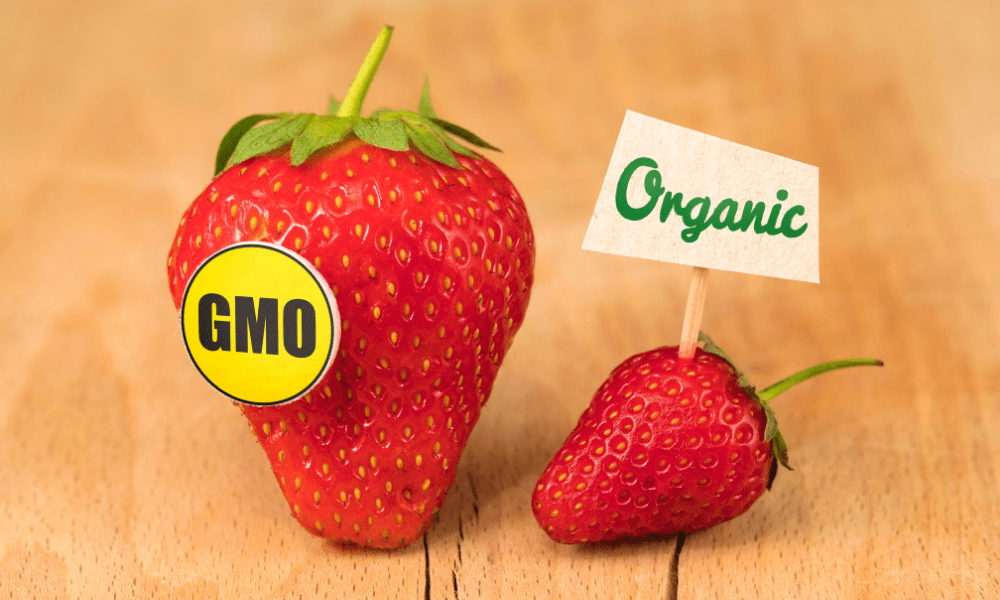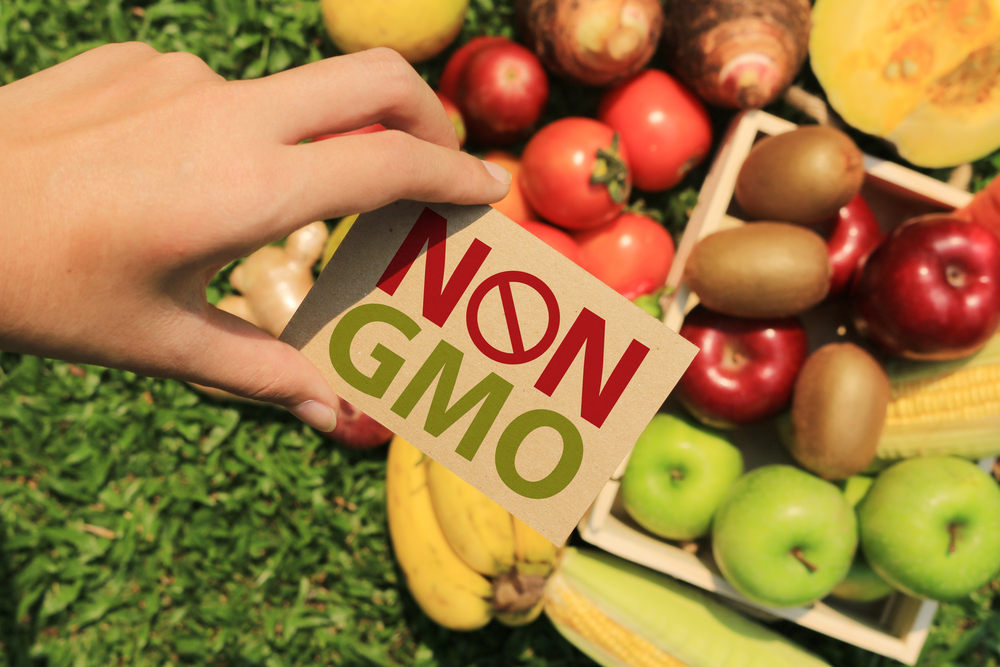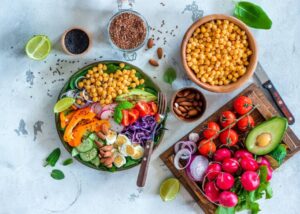Introduction
It’s time for the age-old debate. For all of you out there who grew up on the old farm, this article is just for you. In recent years, the debate over genetically modified organisms (GMOs) versus non-GMO foods has intensified. Consumers are increasingly concerned about the impact of their food choices on health, the environment, and sustainability. So, I’m going to try and provide a comprehensive comparison of GMO vs Non-GMO Food, helping you make informed decisions. You’re welcome.
What are GMOs?

Definition: GMOs are organisms whose genetic material has been artificially manipulated through genetic engineering. We’re not talking about some superpowers, though this seems pretty close to it, wouldn’t you think. This innovative technology allows for the insertion of genes from different species to achieve desired traits, such as resistance to pests or improved nutritional content. For our purposes, it’s to keep foods largely safe for consumption, and as I mentioned before, to keep our food a little bit safer.
Examples of GMO Foods:
- Corn
- Soybeans
- Canola
- Sugar beets
- Papaya
GMO vs. Non-GMO Food: GMO Advantages

- Increased Crop Yields: GMOs are designed to be more resistant to pests, diseases, and adverse weather conditions, leading to higher crop productivity. For all of you farmers out there, some of you may practically survive off of this stuff. For instance, Bt corn has been genetically modified to produce a toxin that is harmful to certain pests, reducing crop losses and increasing yields. That’s more money in everyone’s wallets. Well, at least those who plant the food. As we’ll see later, being cheap goes out the window a little with GMO foods.
- Enhanced Nutritional Content: Some GMOs are engineered to contain higher levels of essential nutrients, such as vitamins and minerals. An example is Golden Rice, which is fortified with vitamin A to help combat vitamin A deficiency in developing countries.
- Reduced Need for Pesticides: Pest-resistant GMO crops reduce the need for chemical pesticide applications, potentially lowering the environmental impact. For example, Bt cotton is engineered to resist bollworms, a major pest, reducing the need for insecticide use.
- Herbicide Tolerance: GMOs like Roundup Ready soybeans are engineered to tolerate specific herbicides, making weed control more efficient for farmers. This can lead to better crop management and potentially higher yields.
GMO vs Non-GMO Food: GMO Concerns

- Health Risks: Some studies suggest potential health risks associated with GMO consumption, although the scientific consensus is that GMOs are safe to eat. There are concerns (rightfully so) regarding allergens and potential toxicity that have not been fully studied.
- Environmental Impact: The widespread use of GMOs can lead to the development of superweeds and pests resistant to conventional control methods, requiring more potent chemicals. Then we have a never-ending biochemical war against our own crops and their weeds. That doesn’t sound like it will end for us, or our food.
- Biodiversity: GMOs can negatively impact biodiversity by promoting monocultures and reducing the variety of crops grown. This can make ecosystems more vulnerable to diseases and pests and reduce the genetic diversity needed for crop resilience.
- Corporate Control: The development and patenting of GMO seeds by large agriculture businesses can lead to increased control over the food supply, potentially disadvantaging small farmers who cannot afford patented seeds or are restricted by licensing agreements. So, maybe it doesn’t look like farmers will get to keep their money. And that doesn’t exactly spell good news for the rest of us.
What are Non-GMO Foods?

Definition: Non-GMO foods are foods that have not been genetically modified. They are grown from seeds that have not been altered using genetic engineering techniques.
Examples of Non-GMO Foods:
- Organic fruits and vegetables
- Certain varieties of crops
- Products labeled with the Non-GMO Project Verified seal
GMO vs Non-GMO Food: Non-GMO Advantages
- Perceived Health Benefits: Many consumers believe that non-GMO foods are healthier and safer than GMO foods. They prefer foods that are produced using traditional breeding methods without genetic manipulation. Although the studies supporting this are relatively unclear, the mental relief it gives people may cause some type of placebo effect.
- Environmental Sustainability: Non-GMO farming practices often emphasize crop rotation, biodiversity, and reduced chemical use, which can benefit the environment. This can be proven. And for those who disagree, spending a couple of years in a chemical field compared to non-chemical field will give you your answer. Organic farming, in particular, focuses on sustainable practices that enhance soil health and reduce pollution. From an agricultural perspective, this is what most farmers have been doing in some shape or form for millennia. Surely, there’s at least a bit of merit to it?
- Support for Traditional Agriculture: Purchasing non-GMO foods supports farmers who use traditional breeding methods and promotes agricultural diversity. This can help preserve heirloom varieties and regional crops that might otherwise be lost. In case you’re wondering what heirloom varieties are, they are plants which have been passed down naturally over generations through open pollination. So, no artificial tampering. Looking at you pesticides.
GMO vs Non-GMO Food: Non-GMO Food Concerns

- Lower Yields: Non-GMO crops may be more susceptible to pests and diseases, potentially resulting in lower yields compared to GMO crops. This can lead to higher production costs and food prices. In today’s growing world, this reality is becoming increasingly harder to accept. Just recently, the Earth has passed the 8 billion people threshold. There’s only so much non-GMO food that can be produced for the sheer amount of people that live on our planet today.
- Higher Costs: Non-GMO foods can be more expensive to produce and purchase due to the need for more intensive farming practices. Organic farming, for example, often requires more labor and careful management. Pesticides, as dangerous to our environment as they are, actually make food cheaper. Thus, it would seem that the more money-saving option are GMO foods.
- Limited Availability: Non-GMO foods may not be as widely available as GMO foods, making it more challenging for consumers to find them. This can be particularly true in regions where GMO crops dominate agriculture.
GMO vs Non-GMO Food: Making Informed Choices

When deciding between GMO and non-GMO foods, consider the following factors:
Health Considerations: Research and personal health concerns should guide your choices. While the consensus among scientists is that GMOs are safe to eat, some consumers prefer to err on the side of caution and choose non-GMO options. Reading labels and understanding what they mean can help you make informed decisions.
Environmental Impact: Consider the farming practices and their effects on the environment. Non-GMO farming often supports biodiversity and reduces the reliance on chemical pesticides and herbicides. Organic farming practices, for example, promote soil health and reduce pollution.
Ethical and Moral Values: Reflect on your values regarding food production, sustainability, and biodiversity. Supporting non-GMO foods can promote agricultural diversity and traditional farming methods. Additionally, consider the ethical implications of supporting large agribusinesses versus small farmers.
GMO vs Non-GMO Food: The Nutritional Debate
:max_bytes(150000):strip_icc()/GettyImages-117452170-56a2b44f3df78cf77278f563.jpg)
The nutritional differences between GMO vs Non-GMO foods are often debated. Some GMO foods are engineered to have higher nutritional value, such as Golden Rice, which is fortified with vitamin A. However, non-GMO foods, especially organic produce, are grown using natural methods and may appeal to those looking for a more “natural” diet.
GMO vs Non-GMO Food: Labeling and Transparency

Understanding food labels can help consumers make informed choices:
GMO Labeling: In many countries, foods containing GMOs must be labeled. Look for terms like “genetically modified” or “bioengineered.” In the United States, the National Bioengineered Food Disclosure Standard requires certain foods to disclose the presence of bioengineered ingredients.
Non-GMO Labeling: Foods labeled with “Non-GMO Project Verified” or “USDA Organic” are guaranteed to be free from genetically modified ingredients. The Non-GMO Project is a third-party verification and labeling organization that ensures rigorous standards for non-GMO products, which helps our organic food lovers find the food that they’re looking for!
GMO vs Non-GMO Food: Consumer Perception and Demand

Consumer perception plays a significant role in the GMO vs. Non-GMO Foods debate. Many consumers associate non-GMO foods with health and environmental benefits. As a result, the demand for non-GMO products has increased, leading to more availability and options in the market. This consumer-driven demand has also prompted more companies to seek non-GMO certification and labeling.
GMO vs Non-GMO Food: Economic Impact

The economic implications of choosing GMO or non-GMO foods are also worth considering:
Cost of Production: GMO crops are often cheaper to produce due to higher yields and lower pest damage. However, the initial cost of developing GMO seeds can be high, and farmers may need to pay licensing fees to use patented seeds. This once again adds a higher cost to our farmers, which are the backbone to the global economy as a whole.
Market Prices: Non-GMO foods tend to be more expensive due to higher production costs and lower yields. Consumers should weigh these costs against their personal and ethical preferences. Additionally, supporting non-GMO and organic farming can contribute to a more sustainable food system in the long term. It’s really now vs. the future. That choice must be made with every individual, not as a collective.
GMO vs Non-GMO Food: Regulatory Frameworks and Policies
Government regulations play a crucial role in the production and labeling of GMO and non-GMO foods. Understanding these regulations can help consumers like you and me make informed choices:
United States: The U.S. Food and Drug Administration (FDA) oversees the safety of GMO foods, while the U.S. Department of Agriculture (USDA) and the Environmental Protection Agency (EPA) regulate their development and environmental impact. The National Bioengineered Food Disclosure Standard requires labeling of bioengineered foods. That’s a lot of government oversight. And with all the chemicals put in our food, I don’t blame them.
European Union: The EU has stringent regulations on GMOs, including mandatory labeling and tracing. Many European countries have banned or restricted the cultivation of GMO crops.
Other Countries: Regulations vary widely, with some countries adopting strict controls and others having more permissive policies. For example, Canada and Australia have comprehensive regulatory frameworks for GMOs, while many developing countries are still formulating their policies. In other words, not everyone has the same government oversight as the West, whether for good or for ill. Though I’m going to make the assumption it’s probably more for ill.
GMO vs Non-GMO Foods: The Future of Food

The future of food production is likely to involve a combination of both GMO and non-GMO methods. Innovations in biotechnology continue to advance, potentially offering new solutions to global food security challenges. At the same time, sustainable farming practices and the demand for non-GMO products will likely persist.
Emerging Technologies: New technologies, such as CRISPR gene editing, offer the potential to develop crops with desirable traits without introducing foreign genes. This could lead to a new generation of “gene-edited” crops that may not be classified as GMOs.
Sustainability Initiatives: There is a growing movement towards sustainable agriculture that integrates both traditional and modern practices. This includes agroecology, regenerative agriculture, and permaculture, which focus on enhancing ecosystem health and resilience.
Consumer Advocacy: Consumers will continue to play a crucial role in shaping the future of food through their purchasing choices and advocacy for transparency and sustainability. Supporting local farmers, participating in community-supported agriculture (CSA) programs, and advocating for clear labeling can all contribute to a more sustainable food system. In other words, it’s up to the people to decide. Our choices will ultimately guide the market. All of them.
Conclusion
The choice between GMO and non-GMO foods is very, VERY complex. By understanding the differences, benefits, and concerns associated with each, you can make informed decisions that align with your health, environmental, and ethical priorities. That may differ from individual to individual, and that is perfectly okay. Everyone is different, going through different circumstances and different environments. Whether you choose GMO or non-GMO, being aware of the implications of your food choices is crucial in today’s world.
FAQs
Q1: Are GMOs safe to eat?
A: According to major health organizations, GMOs are safe to eat. However, some people prefer to avoid them due to potential long-term health concerns.
Q2: How can I identify non-GMO foods?
A: Look for labels such as “Non-GMO Project Verified” or “USDA Organic,” which indicate that the food has not been genetically modified.
Q3: Do non-GMO foods have better nutritional content?
A: Non-GMO foods are not necessarily more nutritious than GMO foods. Nutritional content depends on various factors, including the specific crop and growing conditions.
Q4: What is the impact of GMOs on the environment?
A: GMOs can reduce the need for chemical pesticides but may contribute to the development of resistant pests and superweeds. Non-GMO farming practices often emphasize sustainability and biodiversity.
Q5: Why are non-GMO foods more expensive?
A: Non-GMO foods can be more expensive due to higher production costs, lower yields, and more intensive farming practices. Organic farming, in particular, requires careful management and labor.
Q6: Can GMOs help address global food security?
A: GMOs have the potential to increase crop yields and improve nutritional content, which can contribute to global food security. However, the long-term sustainability and environmental impact of GMOs must also be considered.
References
- National Academies of Sciences, Engineering, and Medicine. (2016). Genetically Engineered Crops: Experiences and Prospects.
- World Health Organization. (2020). Food Safety: Frequently Asked Questions on Genetically Modified Foods.
- American Medical Association. (2012). Report of the Council on Science and Public Health: Labeling of Bioengineered Foods.
- Environmental Working Group. (2021). The Environmental Impact of GMOs.
- Non-GMO Project. (2023). Understanding Non-GMO and Organic Labels.
- USDA Agricultural Marketing Service. (2023). Organic 101: What the USDA Organic Label Means.
- European Commission. (2020). Genetically Modified Organisms: EU Regulations and Safety.
- CRISPR Journal. (2021). The Potential of CRISPR Gene Editing in Agriculture.
- Sustainable Agriculture Research & Education (SARE). (2019). What is Sustainable Agriculture?
By staying informed and considering all aspects of the GMO versus non-GMO debate, you can make the best choices for yourself and your family.




